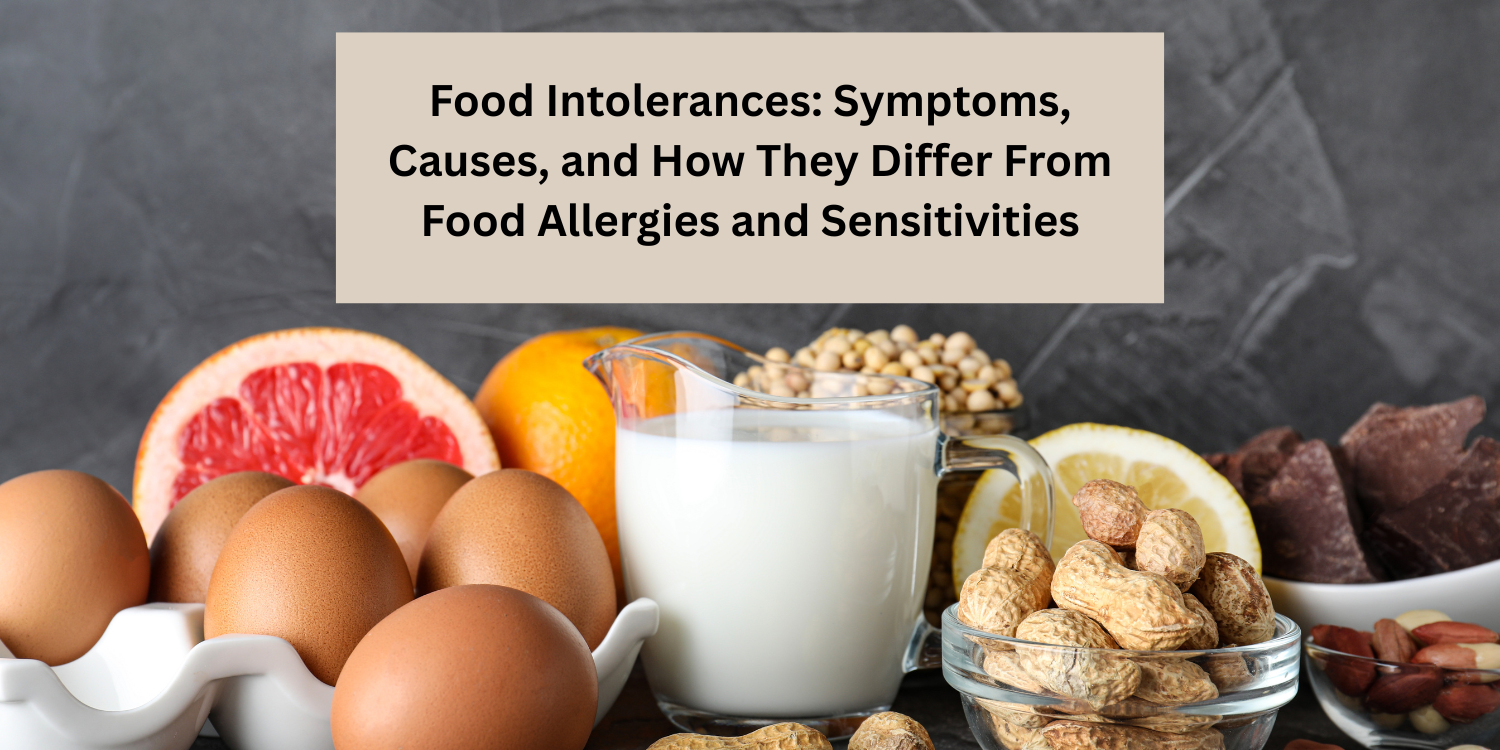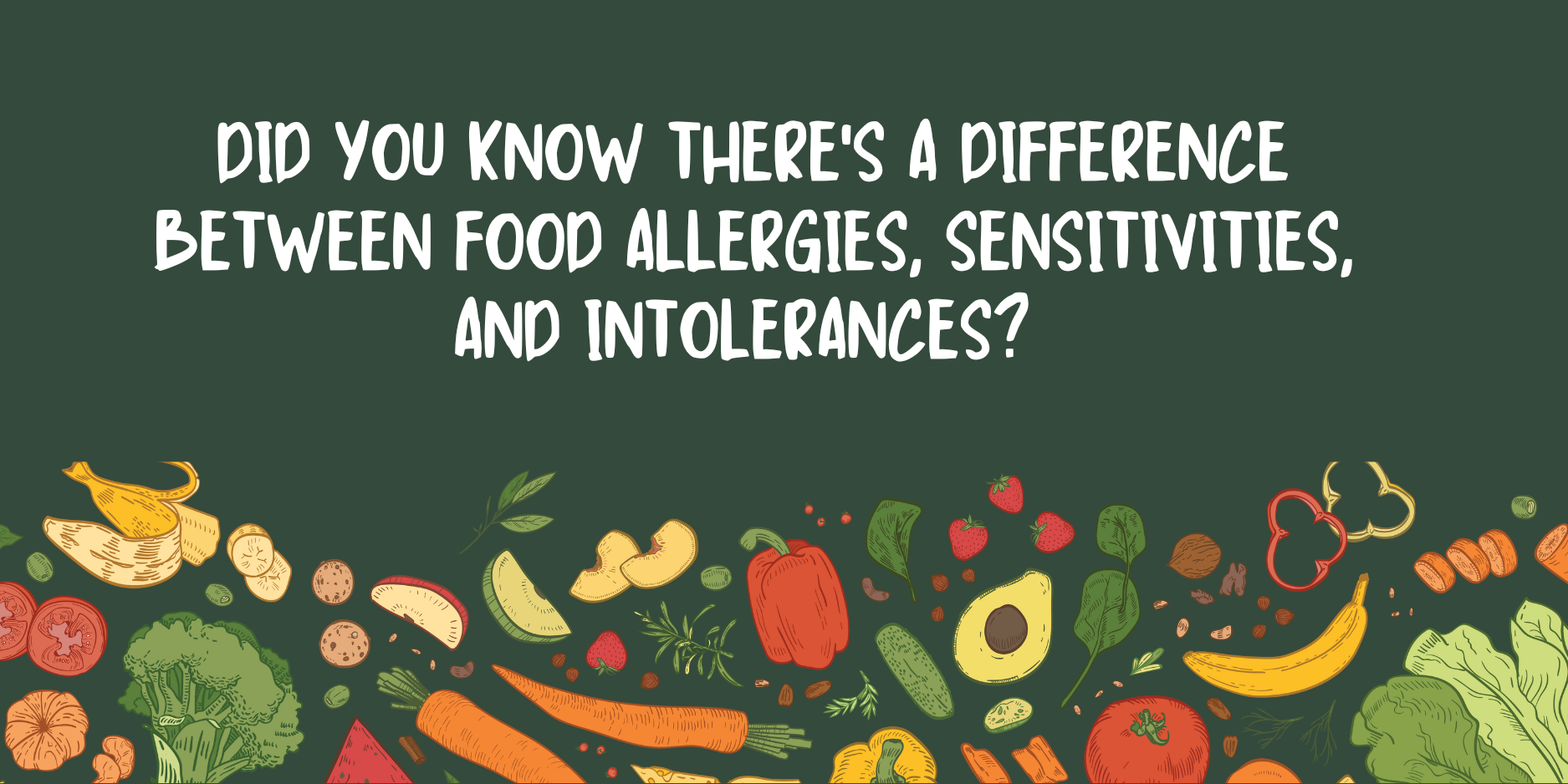

Eating a wide variety of whole foods is a key way to ensure a nutrient-rich diet full of vitamins and minerals. But what happens when you eat something your body doesn’t agree with? For example, you might eat a food item and suddenly experience digestive symptoms like diarrhea, cramping, and bloating—or these symptoms might not appear until days later.
Understanding whether you have a food intolerance is crucial for your health and well-being. But what exactly is food intolerance, and how can you tell if you have it?
To answer these questions, we first need to understand the difference between allergies and sensitivities. Let’s start there.
Food Allergies, Food Sensitivities, and Food Intolerances: What’s The Difference?
Food Allergies
Food allergies are immune reactions that occur after eating something. This reaction occurs when the body’s immune system has an immediate response to certain substances – for example, a peanut. The reaction involves IgE (immunoglobulin E), a specific part of the immune system. A food allergy happens quickly after eating and often includes symptoms like heartburn, stomach pain, abdominal bloating, or sudden diarrhea.
Food Sensitivities
Food sensitivities often involve different parts of the immune system, such as IgG, IgA, or the lymphocyte system. Because food sensitivities cause symptoms up to 3-4 days after consuming a triggering food, they can be particularly challenging to identify. This delayed response makes it difficult to pinpoint exactly which food caused the reaction—whether it was something eaten earlier that day, the previous day, or even several days before.
Food Intolerances
Food intolerances don’t involve the immune system. They are caused by a lack of an enzyme needed to digest a certain food, insufficient enzymes to digest the food completely, or sensitivity to certain chemicals in food. A good example of a food intolerance is lactose intolerance. With lactose intolerance, the immune system is not responding like it is for food allergies or sensitivities. Instead, it’s a lactase digestive enzyme deficiency. In the case of lactose intolerance, the body doesn’t have enough lactase enzyme to break down the lactose from dairy. This causes symptoms like gas, cramping, diarrhea, and abdominal bloating.
Oftentimes, food intolerance symptoms include gastrointestinal issues like:
- Bloating and gas
- Diarrhea
- Nausea
- Abdominal pain or cramping
Common Food Intolerances
Lactose Intolerance
Lactose intolerance occurs when the body can’t properly digest lactose, a sugar found in milk and dairy products. Lactase, the enzyme responsible for breaking down lactose, isn’t produced in sufficient amounts for those with lactose intolerance. This results in undigested lactose coming into contact with the intestinal microbiota, leading to symptoms like diarrhea, nausea, stomach cramps, gas, and bloating.
Luckily, there’s a test that can check for lactose intolerance with a breath test. This is considered the most accurate and non-invasive test. It involves drinking a lactose-containing solution and then measuring the amount of hydrogen gas in the breath at different intervals. Elevated hydrogen levels indicate lactose intolerance.
For those with lactose intolerance, staying away from dairy ingredients and using lactose-free alternatives are key. Lactase tablets, an enzyme supplement, can also help digest dairy products so that dairy and milk can still be consumed. For some, experimenting with tolerance levels can also be helpful, as they may find they can tolerate small amounts of dairy.
Taking probiotics is another way to support the digestive system for those with lactose intolerance, as certain strains of probiotics produce lactase in the gut. Here is a complete probiotic to get started.
Sucrose Intolerance
Sucrose intolerance occurs when the body can’t break down table sugar (sucrose) correctly. This occurs because of a deficiency in the enzyme sucrase. Sucrase is needed to break down sucrose into glucose and fructose.
Sucrose is found in foods like:
- Honey
- Table sugar
- Maple syrup
- Fruits like grapes, bananas, and apples
- Processed foods like soda, cookies, and cakes
A breath test is also used to look for sucrose intolerance. This breath test measures the amount of hydrogen gas produced after consuming sucrose. High levels of hydrogen indicate sucrose intolerance.
For those with sucrose intolerance, a low-sucrose diet is essential. This includes avoiding foods and beverages with high amounts of sucrose like the ones listed above. There is also a prescription enzyme that helps with sucrose intolerance as well.
Fructose Intolerance
Fructose intolerance occurs when the body can’t break down fructose, a sugar found in fruits, vegetables, and processed foods with high fructose corn syrup.
High fructose foods include:
- Juices
- Watermelon
- Apples
- Pears
- Peas
- Asparagus
Reading food labels is also important, as fructose can be found in foods containing:
- Honey
- Molasses
- Palm or coconut sugar
- Agave syrup
- Sorghum
A breath test can test specifically for fructose intolerance. Elevated levels of either hydrogen or methane gases indicate a positive test and likely fructose intolerance.
For those with fructose intolerance, avoiding foods high in fructose is key. This includes fruits, juices, honey, and high fructose corn syrup. It’s generally recommended to avoid foods with more than 3g of fructose per serving. This can often be achieved by sticking with a whole foods, unprocessed diet and being mindful of fructose intake. Foods with lower levels of fructose, like blueberries, strawberries, carrots, green beans, grapes, and lettuce, can often be tolerated when eaten in small amounts during a meal.
Oxalate Intolerance
Oxalates are naturally occurring compounds found in certain plants like spinach, beets, rhubarb, almonds, chocolate, and certain legumes like navy beans. Oxalate intolerance occurs when the body has difficulty processing oxalates. When too much oxalate is consumed, crystals can form in the kidneys, intestines, and other organs. Symptoms can include kidney stones, fatigue, joint pain, and gastrointestinal symptoms like nausea, vomiting, and abdominal pain.
To test for oxalate intolerance, an elimination diet is recommended for at least 3 weeks. This includes not eating any oxalate-containing foods for the duration of the elimination period. If symptoms improve, reintroducing small amounts of oxalate-containing foods can be tolerated by some individuals. Staying well-hydrated and increasing calcium intake with meals can also help, whether through a calcium supplement or calcium-rich foods, as calcium binds to oxalates. Oxalate levels can also be checked in the urine, although presence of oxalates or oxalate crystals in a regular urinalysis does not necessarily mean there is an oxalate intolerance. Sometimes a 24 hour collection is needed in order to fully assess.
Salicylate Intolerance
Salicylates are organic compounds produced by plants as a natural defense mechanism. They’re found in fruits, vegetables, coffee, nuts, spices, and honey. It’s also used in medications like aspirin and can be found in cosmetics and cleaning products. Salicylate intolerance occurs when the body isn’t able to process the salicylates ingested.
Foods high in salicylates include:
- Berries, including strawberries, raspberries, cranberries, and blueberries
- Citrus fruits, including lemons, limes, and oranges
- Stone fruits, including peaches, plums, apricots, and cherries
- Certain vegetables like celery, cucumber, mushrooms, onions, peppers, and spinach
- Certain nuts and seeds, including almonds, peanuts, pine nuts, sesame seeds, and cashews
Symptoms of salicylate intolerance include nasal congestion and asthma, headaches, hives, rashes, stomach pain, and diarrhea.
An elimination diet for 3 weeks is used to test for salicylate intolerance. If symptoms improve, salicylate intolerance is likely the culprit.
Mold Intolerance
Mold is widespread and can be found in a variety of environments, like water-damaged buildings, and foods.
Foods more commonly found to have mold in them include:
- Grains like barley, oats, rice, corn, wheat, and rye
- Mushrooms
- Milk and meat from grain-fed animals
- Certain cheese
- Wine and beer
- Dried fruits
- Some fermented foods.
Those with mold intolerance react more severely to mold than others, with symptoms including itchy eyes, headaches, runny nose, rash, and – in some cases- difficulty breathing.
An elimination diet for 3 weeks is recommended to see if symptoms improve. This includes avoiding foods commonly found to have mold in them and also avoiding processed or refined foods. If symptoms improve, continuing to avoid the foods or environment causing exposure is recommended. Of course we can test for mold metabolites via a mycotoxins test, but that does not always correlate to mold intolerance.
Histamine Intolerance
A histamine intolerance results from an imbalance of histamine intake through diet and a decreased ability to metabolize the ingested histamine. This leads to an increased histamine concentration in the blood, causing adverse effects like abdominal distention and pain, constipation, and/or diarrhea, more commonly diarrhea. For some, histamine intolerance can also cause symptoms outside of the gastrointestinal tract, like headache, dizziness, increased heart rate, nasal congestion, or even difficulty breathing.
Foods with high histamine content include:
- Hard and semi-hard cheese
- Shellfish and oily fish
- Fermented meat, vegetable, and soy products
- Wine and beer
- Eggs
- Chocolate
- Mushrooms
- Left Overs
An elimination diet for 3 weeks is recommended to diagnose histamine intolerance. The elimination period includes focusing on foods with low histamine content. Basic foods to avoid include the ones listed above. If symptoms improve, histamine intolerance is likely to blame and continuing to avoid triggering foods is recommended. While we can check for histamine levels in the blood, there are many patients with normal levels that still improve on a low histamine diet.
How Functional Medicine Can Help Food Intolerances
Are you experiencing uncomfortable digestive symptoms after eating certain foods? You may have a food intolerance – and functional medicine can help. Through elimination diets and specialized testing, we identify the root cause of your symptoms and create a management plan that works for you. Since functional medicine views the body as an interconnected system, you can trust that your health will be addressed comprehensively. We don’t believe in one-size-fits-all solutions—our approach is tailored to your unique body and health needs.
At Arizona Wellness Medicine, we begin with a thorough assessment. Our experienced team uses comprehensive testing to understand your health, symptoms, and underlying causes. Once we identify which food intolerances are triggering your symptoms, we develop a personalized treatment plan specifically for you. Contact us here to book your first appointment.
Resources:
- Food Allergies, Sensitivities and Intolerances
- Blood Testing for Food Sensitivities
- Food Elimination Plan Goals
- Food Intolerance: The Role of Histamine
- Myths and Facts about Food Intolerance: A Narrative Review
- Dietary fructose intolerance, fructan intolerance and FODMAPs
- Mold Toxicity: How to Diagnose and Treat Mold Exposure For Good
- Salicylate Intolerance
Share:
Dr. Emily Parke
Social Media
Most Popular Posts
Subscribe To Our Newsletter
Related Posts

New Podcast Episode: My journey into functional medicine + what I’ve learned
I’m excited to share that I recently joined DeLo for Episode 165 of the On the DeLo podcast! In this conversation, we explored my journey

Understanding the Essential Labs for Women on Hormone Replacement Therapy (HRT)
So what are the minimum labs we’re looking at when we do hormone replacement therapy? We obviously want to look at an estrogen level, so

How to figure out the right amount of HRT in women
What about checking lab values when you’re on hormone replacement therapy? I do find it to be helpful, but we also want to consider symptoms.

Did you know there’s a difference between food allergies, sensitivities, and intolerances?
Did you know that there’s a difference between food allergies, food sensitivities and food intolerances? Food allergies, the reactions tend to happen pretty immediately and
